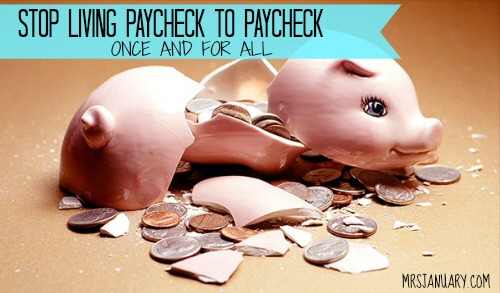Stop living paycheck to paycheck once and for all
Are you tired of living paycheck to paycheck? Do you have trouble sleeping because funds are just too tight? Do you worry daily about what you would do if there were an emergency – because you have no money in savings? If so, you’re not alone.
The Globe and Mail stated in May of 2013 that one-third of Canadians are living paycheck to paycheck. Ouch.
Stop living paycheck to paycheck once and for all
Paycheck to paycheck living is extremely stressful and can cause major disturbances in your life and your relationships. So why do so many Canadians put themselves in that situation? The reasons are amazingly varied.
For some, it’s a lack of employment, illness, or worse. However, for many others, it’s simply overspending. Notice the word “simply”. Overspending is SO simple to do.
If you’re serious about stopping the paycheck to paycheck cycle, it will take time, determination, and hard work. But you can do it!
To stop the paycheck to paycheck cycle you will need to:
- Track all of your spending.
- Track all of your income.
- Study the numbers. They don’t lie.
- Pay yourself first.
- Make hard choices and cut expenses.
- Earn more money.
- Stick to your budget.
Let’s look at each area in some detail.
Track all of your spending.
And this means down to the dollar (yes, really). For at least one month (preferably longer), write down every single thing you spend money on. From groceries to electricity and from coffee to socks.
It’s important to be truthful during this stage – remember, you are ready to beat this paycheck to paycheck cycle once and for all.
Track all of your income.
Over the same length of time, write down every single dollar you earn. More specifically, every single dollar that comes into your bank account after all taxes, benefits, and the like. This is your take-home pay.
Of course, your paycheck will be on the list, but there is likely other money you receive. Perhaps a Child Tax Credit or other government money.
Study the numbers. They don’t lie.
This is likely the most important step. As long as you have been truthful about the above tracking, you will be able to clearly see how much (and where) you are overspending.
You may be surprised by these numbers, or perhaps they were fairly close to what you suspected.
Your “guesstimates” have been thrown out the window, now. Even though you may have budgeted $150 a week on groceries, you may now clearly see that you actually spend $208 on average per week. Over the month, that is already $232 your budget did not account for.
Pay yourself first.
Before you make any choices about how to cut expenses, how to make more money, or what on earth you are going to do – let’s cut your income a little more by paying yourself first, shall we?
Although this may, at the moment, seem impossible – it’s not. I promise. You have to do it to get out of this vicious cycle.
This is the hard stuff I was telling you about. Starting right now, take 10% of your take-home income and pay yourself first each month. Put that money into savings.
If your monthly income was $4250, this means that every month you will be paying yourself $425, without exception.
It’s best to make this amount come right off of a paycheck so you don’t even see it. This is your ticket to staying out of the paycheck to paycheck cycle – take it seriously.
Make hard choices and cut expenses.
Now comes the tricky part. You have to be really tough with yourself here. You must live within your means. And remember your means are your actual take-home income minus paying yourself first money. In our example above, our monthly money would be $3825.
First of all, subtract any monthly debts you have. Now you’re ready to figure out how much money you can really spend each month. You may discover quite quickly that this money doesn’t go very far. Be tough here. You may only need to make these cuts temporarily.
Do you really need cable? Can you avoid most fast food? Can you make coffee at home? These are all great places to start. But get into those deep questions you are avoiding: Can I go without my car? Should I downsize my house?
Gulp. I know – not at all easy to face questions like this, but it will certainly let you see where your priorities lie.
Earn more money.
Now, of course, you need to have a bit of wiggle room. You cannot possibly never have a cup of coffee out of the house, or never go out with a friend for lunch. That is definitely not sustainable, and you don’t want these certainties to blow your whole budget when they happen. You may just need to make more money.
Depending on your job, this may be simple. Perhaps you can pick up an extra shift. For others, you may need to get creative. Look at your interests and talents and any needs in your community. Get as creative as you can. Could you: Babysit? Does Pet sit? Walk dogs? Tutor? Care for kids after school? Sell homemade things? Sew or tailor?
Any extra money you bring in should be considered exactly that: extra. It means it cannot be depended on. If it’s a new regular source of income, add it to your “income” and re-budget accordingly – you have given yourself a bit more wiggle room.
This extra money category can be thought of as something different. It could be for anything from going out for lunch to going on a trip to Europe. You don’t need to feel guilty about it because you already have a budget you are sticking to and you are building your savings each paycheck. This is guilt-free money!
Stick to your budget.
Enough said. If you make a budget, the only way you will succeed is if you actually stick to that budget!
There are many ways to avoid the paycheck to paycheck cycle, but this is a way that has worked well for my family. Following these steps will give you money in savings, and extra money for guilt-free spending.
Picture a life where you don’t have to worry about money. Now achieve that life. You can do it.




Comments
Love this article Sarah. You have outlined a lot of practical steps. September is a perfect time to try new systems and make new “resolutions” so I hope people will take you up on your challenge to break the cycle. My husband and I are always looking at the numbers for new ways to trim. It can be fun if you see it as a challenge.